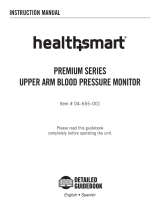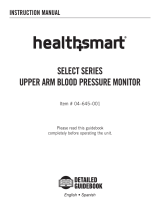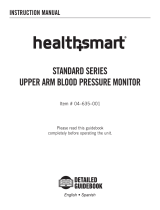Page is loading ...

INSTRUCTION MANUAL
SmartRead
™
Digital
Blood Pressure Monitor
Guidebook
Model 04-244-001
Please read this instruction manual
completely before operating this unit.
MABIS
.
THCARE INC
HEAL
™

Limited Five Year Warranty
Your Mabis Blood Pressure Monitor is guaranteed to be
free of manufacturing defects for a period of five years
from the date of purchase under normal use. If the unit
fails to operate during warranty period, return it prepaid
along with $5.00 for return shipping and insurance to:
Mabis Healthcare Inc., Attn: Repair Department,
28690 N. Ballard Drive, Lake Forest, IL 60045.
If it is determined to be a manufacturing defect, the
unit will be repaired or replaced at the option of Mabis
Healthcare.This warranty gives you specific legal rights
and you may also have other rights which vary from
state to state. As a condition of this warranty, the
enclosed warranty registration card must be completed
and sent to us within 10 days of the purchase date.
MABIS
.
THCARE INC
HEAL
™
28690 N. Ballard Drive
Lake Forest, IL 60045 USA
Toll-Free Customer Care Helpline:
800-622-4714
www.mabis.net
E-mail: 244inf[email protected]
Phone: 847-680-6811
Fax: 847-680-9646

Introduction . . . . . . . . . . . . . . . . . . . . . . 2
Product Identification & Caution . . . . . . . 3
General Blood Pressure Information . . . . 4-6
Important Information Before Use . . . . . . 7
Battery Installation/Replacement . . . . . . 8
AC Adapter Installation (Optional) . . . . . 9
Applying Your Blood Pressure Cuff . . . . . 10-11
Taking Your Blood Pressure Reading . . . 12-13
Error Display Symbols . . . . . . . . . . . . . . 14
Memory Features . . . . . . . . . . . . . . . . . . 15
Care and Maintenance . . . . . . . . . . . . . . 15
Troubleshooting . . . . . . . . . . . . . . . . . . . 16
Product Specifications . . . . . . . . . . . . . . 17
Sample Blood Pressure Log . . . . . . . . . . 18
Index
1

To achieve the maximum benefit from your blood pressure monitor,
we recommend that you first consult with your physician or trained
health care professional.
Thank you for purchasing a Mabis Automatic Digital Blood Pressure
Monitor.With proper care and use, your monitor will provide you
with many years of reliable readings.
The method of measurement that your Automatic Monitor uses is
called the oscillometric method.The monitor detects your blood’s
movement through the artery in your arm and converts the move-
ments into a digital reading.The oscillometric method does not
require a stethoscope, making the monitor easy-to-use.
Your Automatic Monitor is specially enhanced with SmartRead™
Technology. With the touch of a button, the cuff will automatically
inflate to the optimum level.Within seconds, the cuff will deflate at
the proper rate of 3-4 mmHg per pulse beat.Your blood pressure
and pulse readings will be clearly displayed on the large digital
panel.
Blood pressure readings determined with this device are equivalent to
measurements obtained by a trained observer using the cuff/stethoscope
auscultation method, within the limits prescribed by the American National
Standard for Electronic or Automated Sphygmomanometers.
Introduction
2

Product Identification
3
Cuff
Power/Start
Button
Digital
Display
Panel
Cuff
Jack
AC
Jack
Cuff
Tubing
Tubing
Connector
Ring
Caution
You can stop the inflation or deflation
process of the cuff at any time by
pressing the “power” button causing
the cuff to immediately deflate.
Batteries “AA”
(Alkaline 1.5V x 4)

What is Blood Pressure?
Blood pressure is the pressure that is exerted by blood flowing against the
walls of the blood vessels throughout your body.
Your heart, which is the center of the circulatory system, provides the force for
the blood to flow or circulate.When your heart contracts or beats, the blood is
forced through the blood vessels increasing the pressure.This is the highest
pressure in the cycle or what is referred to as SYSTOLIC BLOOD PRESSURE.
In between beats, your heart relaxes and your blood pressure decreases.
This is referred to as DIASTOLIC BLOOD PRESSURE.
This complete series of events which occurs in a single heartbeat is known
as the CARDIAC CYCLE.
Your Mabis Automatic Monitor will automatically read your blood pressure and
display both systolic and diastolic readings on the screen.Your systolic will be
positioned as the upper number and the diastolic reading will be the lower
number.
(systolic)
120
/80
(diastolic)
Blood pressure is measured in millimeters (mm) of Mercury (Hg) and is general-
ly recorded with the systolic pressure (120) listed first and the diastolic pressure
(80) listed second.The numbers are typically separated by a slash mark (/) as
shown above.
Both pressure readings, the SYSTOLIC and the DIASTOLIC, are necessary for
a physician to evaluate the status of a patient’s blood pressure.
Please contact your physician for specific information regarding your own blood
pressure.
General Blood Pressure Information
4

What Influences Blood Pressure?
Many factors such as genetics, age, sex, altitude, physical
activity, anxiety, muscular development, certain medications or
even the time of day can influence blood pressure. Influences
such as sleep or relaxation decreases blood pressure, while
anxiety or exercise increases blood pressure.
Why Monitor Your Blood Pressure at Home?
A visit to a physician’s office can be a stressful situation
for a patient. And, anxiety is a known factor in raising blood
pressure.This temporary occurrence of elevated blood
pressure at the physician’s office is commonly referred
to as “white coat syndrome”.
Whether or not you experience “white coat syndrome”, home
blood pressure monitoring provides you with the opportunity
to supplement your physician’s office measurements.These
home readings, when taken over a period of time, can show
an accurate indication of change. Furthermore, your records
can assist your physician in evaluating your health and
in making important decisions in the diagnosis and treatment
of your condition. Because of this, it is important to take
consistent, daily measurements of your blood pressure.
The variations in your individual readings should only be
interpreted by your physician or a trained health care
professional.
5

6
WHO Blood Pressure Classifications
Standards for assessment of high or low blood pressure, regardless of age,
have been established by the World Health Organization (WHO) as shown
in the following chart.
Reference Material: Investigation into Adult Diseases Report
by the Ministry of Health and Social Security, 1971.
This chart is only a general guideline. Please contact your
physician to determine your NORMAL BLOOD PRESSURE.
Variations in Blood Pressure
Blood pressure can be influenced by many factors.This change can occur
from moment to moment. Normally, blood pressure is lowest during the
sleeping period and rises during the day.The graph below represents the
variations in blood pressure shown over a day with measurements taken
every 5 minutes.
The dotted line represents the
sleep period.The rise in blood
pressure at 1 PM
(A in the
graph)
corresponds to a stress-
ful occurrence and at 7 PM
(
B in the graph)
a period of
exercise.
Hypertense
Pressure Type
mmHg
160
140
mmHg
95
90
Systolic Blood Pressure
Diastolic Blood
Pressure
Normal Blood
Pressure Type
Borderline
Type
180
140
120
100
80
60
40
20
1212 3456 78910111212 34567891011
AMPM Time
Blood Pressure (mmHg)
B
A
I I I I I I I I I I I I I I I I I I I I I I I I
sleep

7
1. Blood pressure measurements should only be interpreted by a physician
or a trained health care professional who is familiar with your medical history.
Through regular use of this device and recording of your measurements, you
can keep your physician informed of the changes in your blood pressure.
2. Perform your measurement in a quite place.You should be seated in a
relaxed position.
3. Avoid smoking, eating, taking medication, alcohol consumption or physical
activity 30 minutes prior to taking a reading. If you are exhibiting signs of
stress, avoid taking your measurement until the feeling subsides.
4. Rest 15 minutes prior to taking a reading.
5. Remove any constrictive clothing or jewelry that may interfere with the cuff
placement.
6. Apply the cuff to the proper position on the left arm.The monitor should be
positioned flat with the digital display panel in view.
7. Keep the monitor stable during measurement to achieve an accurate reading.
Remain still; do not talk during the measurement.
8. Record your daily blood pressure and pulse readings on a chart.
9. Take your readings at the same time, each day (or as recommended by your
physician) to get an accurate indication of change in your true blood pressure.
10.Wait a minimum of 15 minutes between readings to allow for the blood
vessels to return to normal. The wait time may vary depending on your
individual physiological characteristics.
11.Although such cases are rare, for those with an extremely weak pulse or
irregular pulse, errors may result which prevent proper measurement.
If abnormal variations are noticed, consult with your physician or a
sales representative from where you purchased this unit.
12.This device is intended for adult use. Please consult your physician
should you wish to use the device on children.
While taking a measurement, you can stop the inflation or deflation process
of the cuff at any time by pressing the power button.
Important Information Before Use

8
Battery Installation/Replacement
Low Battery
Indicator
1. Remove the battery cover as shown in
Fig. 1.
2. Insert the batteries into the compartment,
Fig. 2,
taking care to
observe and match the polarities as indicated on battery compartment.
3. Replace the battery cover,
Fig. 3.
Note:
The batteries in your monitor will need to be replaced when
the Low Battery indicator appears on the display,
Fig. 4.
Replace the batteries with four new “AA” alkaline batteries.
4. We recommend that you remove the batteries if the unit will not
be used for an extended period of time.
Fig. 1
Fig. 2
Fig. 3
Fig. 4

9
AC Adapter Installation (Optional)
Fig. 1
Your Mabis Blood Pressure monitor will operate on 4 “AA” batteries
(included) or a standard 6V/600mA AC adapter fitted with a
DIN plug (not included).
To use an AC adapter:
1. Insert the DIN plug
into the socket located
on the left side of the
monitor,
Fig. 1.
2. Plug the AC adapter into a main outlet
according to the adapter’s specifications.
3. Test the connection by pressing the power button.
Note:
Your unit will not draw from the batteries while using an AC adapter.
If the AC is interrupted during use, you will need to reinsert the
DIN plug once the power becomes available.

Applying Your Blood Pressure Cuff
10
Fig. 1
1. Remove any constrictive clothing or
jewelry that may interfere with the
cuff placement.
2. You should be seated with your feet
flat on the floor.
3. Position the cuff on a solid surface
with the tubing facing UP and AWAY
from you,
Fig. 1.
The metal bar on
the cuff should be to the left of the
tubing, underneath the cuff.
4. Widen or open the cuff by pulling or
rolling the bottom of the cuff towards
the right,
Fig. 2.
This should open
the cuff, creating a cylinder.
Do not extend the cuff beyond the
metal bar.
Avoid smoking, eating, taking medication, alcohol consumption or physical activity
30 minutes prior to taking a reading. If you are exhibiting signs of stress, avoid taking
your measurement until the feeling subsides.
Rest 15 minutes prior to taking a reading.
Note: If for any reason you are unable to or should not use your left arm, please
modify the following instructions and apply the cuff to your right arm.Your physician
can tell you which arm is best for you to use.
Fig. 2

11
Applying Your Blood Pressure Cuff
5. Insert your left arm into the cuff
(cylinder).The bottom edge of the
cuff should be positioned one inch
ABOVE the elbow joint,
Fig. 3.
The tubing should extend
towards your hand.
6. With your left arm extended in front
of you and palm facing upward,
postion the tubing down the center
of your arm
Fig. 4.
7. Reaching underneath your left arm
with your right hand, pull the end
of the cuff towards your body to
tighten the cuff,
Fig. 4.
Wrap and
secure the cuff making sure that
the tubing position remains as
shown,
Fig. 5.
8. The cuff should fit comfortably, yet
snugly around your arm.There
should not be any gap between
the arm and the cuff.
Fig. 3
Fig. 4
Fig. 5

12
Taking Your Blood Pressure Reading
1. Position the monitor on a flat, stable
surface with the digital display panel
in view. Insert the cuff tubing into the
left side of the monitor,
Fig. A.
2. Rest your elbow on a table with your
palm facing upward. Elevate your hand
so that the cuff is at the same level as
your heart,
Fig. 1.
Relax your left hand.
3. Press the power button.The unit will
run a self-test,
Fig. 2.
4. Upon release, beeps will sound and
the display will briefly change to a
flashing symbol,
Fig. 3.
The cuff is
ready for automatic inflation.
Proceed only after reading the previous sections of this manual.
Fig. A
Fig. 3
Fig. 2
Measurement value
becomes lower.
Correct measurement
position (at same
height as heart).
Measurement value
becomes higher.
Fig. 1

Taking Your Blood Pressure Reading
5. The display will show the increasing
pressure in the cuff,
Fig. 4.
6. When a pulse is detected, the unit will
sound for each beat and the display
symbol will flash,
Fig. 5.
7. A long beep will indicate that the
measurement process is complete and
the cuff will automatically deflate.Your
blood pressure (systolic and diastolic)
measurement and pulse rate will be
simultaneously displayed,
Fig. 6.
8. To conserve energy, press the “on/off”
button to turn the power off. Otherwise
the unit will automatically shut off after
approximately 5 minutes.
If you need to take another measurement,
wait a minimum of 15 minutes between
readings to allow for the blood vessels to
return to normal.The wait time may vary
depending on your individual physiological
characteristics.
13
Fig. 4
Fig. 5
Fig. 6
Pulse
Diastolic
Systolic

Error Display Symbols
Display Symbol Condition/Cause Corrective action
• Cuff pressure drops
to less than 20 mmHg
before achieving reading.
• Movement is detected
during reading or low
inflation level.
• Cuff inflation takes too
long.
Wait a minimum of
15 minutes and
remeasure. Loosen
cuff to allow
circulation of blood
while waiting.
Check cuff and hose
connections.
14

1. Only use a soft, dry cloth to clean your blood pressure monitor.
2. Avoid using any types of liquids on the monitor or cuff.
3. Do not store the unit where it will be exposed to direct sunlight,
dust or humidity. Avoid extreme temperatures.
4. Never disassemble the monitor or cuff.
5. Dropping or subjecting your blood pressure monitor to strong
shocks should be avoided.
6. Twisting or applying force to the cuff will cause damage to
the sensitive interior components.
Care and Maintenance
15
Memory Features
Your Mabis Digital Blood
Pressure monitor features last
reading memory. To view your
previous reading, press and
hold the power button for
approximately 3 seconds until
the display is blank,
Fig. 1.
Upon release of the button, the
last measured pressures and
pulse rate will be displayed,
Fig.
2.
Fig. 1
Fig. 2

16
If any abnormality occurs during use, please check and correct the following:
Condition Correction
Display is blank Check and correct the polarity
when power is on. of the installed batteries.
Reinstall or replace batteries.
Cuff pressure does not increase Check and reconnect cuff
after pressing “start” button. attachment and hose.
Measurement incomplete Review and follow “Applying Your
or abnormally low or Blood Pressure Cuff” and “Taking
high values displayed. Your Blood Pressure Reading”
sections.
Measurements are different Remember, blood pressure
from those typically measured readings are influenced by
by physician or every physical and mental conditions
measurement reading is and/or even the time of day.
different. Daily measurement recordings
should be presented to your
physician for interpretation.
Cuff pressure falls very slowly Tubing connector ring is missing
or not at all. Measurement and must be reattached. Removal
is not obtainable. of the ring should be avoided.
Troubleshooting

17
Name and model number SmartRead™ Digital Blood Pressure Monitor,
04-244-001
Display system Digital display system/LCD
Measuring method Oscillometric method
Power source “AA” type alkaline batteries 1.5V x 4
Measuring range 30⬃280 mmHg (Pressure)
40⬃200 Pulse/minute (Pulse)
Accuracy Within ⫾3 mmHg (Pressure)
Within ⫾5% of the reading (Pulse)
Pressurization Capacitive sensor
Memory Built-in memory enabling display of
previously measured value.
Automatic Power Off Automatic shut off after approximately
5 minutes of non-use to conserve energy.
Storage
Temperature 23°F - 122°F
Humidity 15% - 85% RH
Operation
Temperature 50°F - 104°F
Humidity 15% - 90% RH
Monitor Dimensions 7-1/8” x 4-5/8” x 2-7/8”
Weight 1 lb. (with batteries)
Cuff Arm Circumference
Range Fits arm circumference: 9-1/2” - 12-5/8”
(24-32 cm)
Accessories Adult size cuff, detailed guidebook,
four “AA” batteries.
Options (sold separately) Small adult size cuff, fits arm
circumference: 6-1/4” - 9-7/8” (16-25 cm)
Large adult size cuff, fits arm
circumference: 12-1/4” - 16-1/8” (31-41 cm)
AC adapter
Specifications are subject to change without notice.
Product Specifications

18
Sample Blood Pressure Log
/





